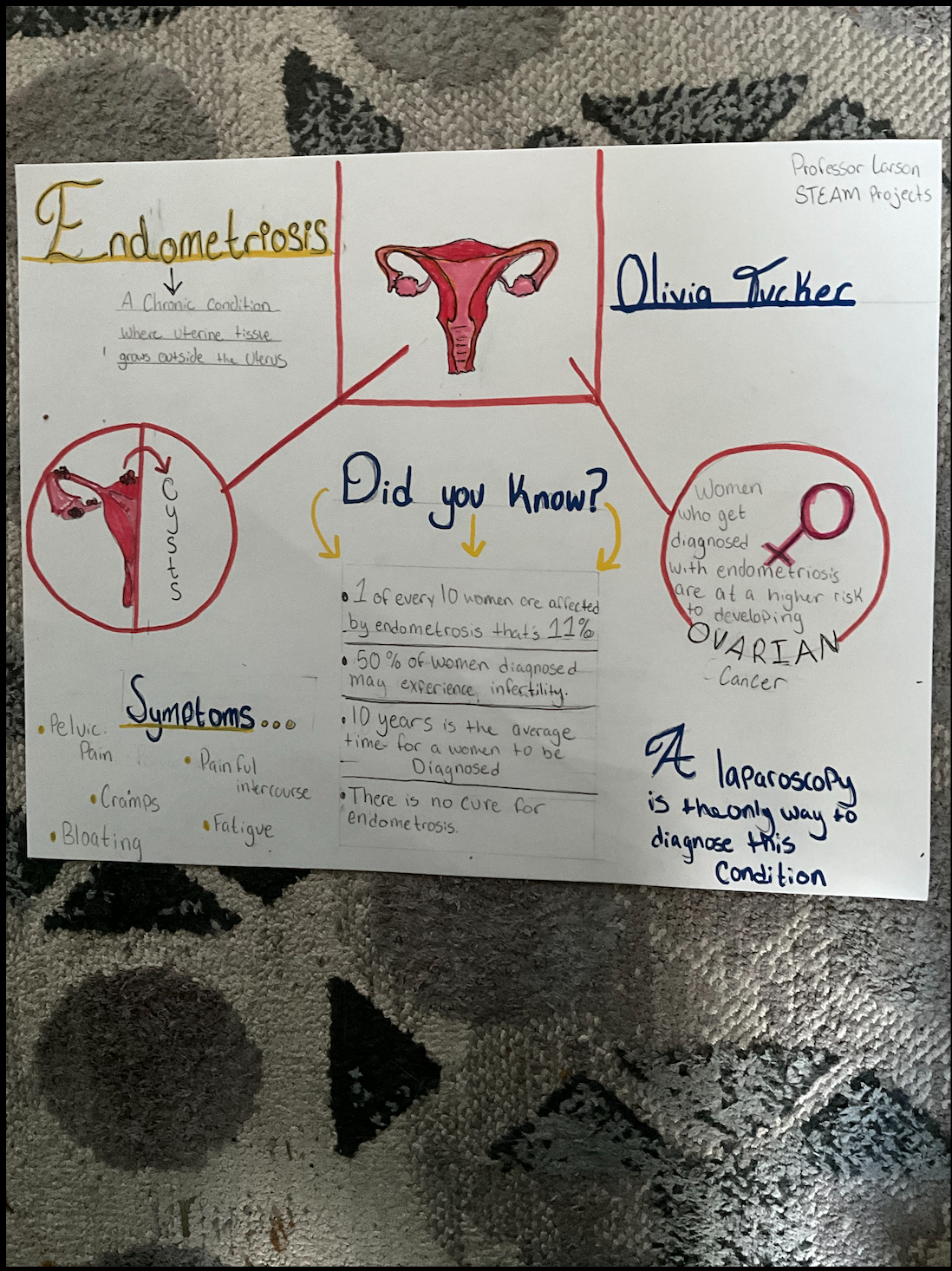Olivia Tucker
University of Fairbanks, Alaska
Human Anatomy & Physiology
Professor Larson
April 18, 2024
The course objective I would like to cover in this paper are:
- What Endometriosis is
- How does endometriosis affects women
- Uterus tissue types & Endometriosis cysts
Endometriosis
About 5 million women in America suffer from endometriosis. The cause of endometriosis is unknown. There is no known way to prevent endometriosis. There is no cure, but its symptoms can be treated with medicines or, in some cases, surgery. (Cherokee Women’s Health). My objective for this paper is to identify types of tissue within the uterus and learn more about what endometriosis is.
The endometrium, which normally lines the lining of your uterus, develops outside of it (endometrial implant), a condition that is frequently uncomfortable. Most frequently, endometriosis affects the tissue lining your pelvic, bowel, or ovaries. Endometrial tissue can sporadically extend outside of your pelvis. With every menstrual cycle, endometriosis tissue undergoes the same thinning, disintegration, and bleeding as the uterine lining. However, it remains within the body and grows in unwanted places. Endometriomas, or cysts, can develop in the ovaries as a result of endometriosis. Inflammatory surrounding tissue can result in the formation of scar tissue. Adhesions, which are bands of fibrous tissue, can also develop. These may result in pelvic organs and tissues adhering to one another. Pain can be a symptom of endometriosis, particularly during the menstrual cycle. Issues related to fertility may also arise. However, there are medicines that might help you manage the illness and its side effects.
Some endometriosis sufferers experience no symptoms at all. Pain in the lower abdomen (pelvis) is a typical symptom for those who have it. The times when urinating or defecating during or after a sexual encounter may be the most painful. Some women additionally encounter; persistent pelvic discomfort, heavy bleeding during or between periods, bloating or nausea, exhaustion, depression, or anxiety, and difficulties with infertility. A director at Hackensack University Medical Center in New Jersey, a pelvic reconstruction surgery and urogynecology directos says “The first signs of endometriosis aren’t always easy to identify and while some people may suffer from severe symptoms, others may not have any,” says Khashayar Shakiba, M.D. (Healthcentral)
The development or survival of ectopic endometrial tissue may also be influenced by additional variables. For instance, it is well recognized that endometriosis is estrogen-dependent, and that this boosts the disease’s progression, inflammation, and discomfort. The complex association between endometriosis and estrogen is due to the fact that endometriosis is not always present in the absence of estrogen. (W.H.O.)
The uterus is a pear-shaped, hollow organ that performs a number of tasks, including menstruation, labor and delivery, and gestation (pregnancy). Its cavity has the shape of an inverted triangle on a coronal cut section. Three tissue layers make up the uterus, and they are as follows; the endometrium, which is made up of the basal and functional endometrium, is the inner lining. Hormones related to reproduction affect the functional layer. Menstrual bleeding is the result of this layer shedding. Adhesions and fibrosis may develop as a result of injury to the basal endometrium (Asherman syndrome).The smooth muscle cells that make up the myometrium are the layer of muscle.The myometrium is the middle layer, which is incredibly muscular. This is the part that contracts and expands to push the baby out during pregnancy. Serosa/Perimetrium: the thin layer of epithelial cells that makes up the outer layer. A lubricating fluid secreted by the serous layer aids in lowering friction. The peritoneum, which covers some of the pelvic organs, also includes the perimetrium.(StatPearls. (n.d.)
Cystic lesions resulting from endometriosis are called endometriomas.They are sometimes called “chocolate cysts” and are filled with dark brown endometrial fluid. An advanced stage of endometriosis is indicated by the presence of endometriomas. The ovaries are the most typical location for endometriomas. About 10% of women who are of reproductive age have endometriosis, which is frequently the cause of infertility, dyspareunia, dysmenorrhea, and chronic pain. Endometriosis is most frequently found in the pelvis, most especially on the ovaries. (NCBI)
Endometriosis is defined as a long-term gynecological disorder with a wide range of intricate symptoms, such as infertility, difficult intercourse, excessive bleeding, and persistent pelvic pain. Based on estimates, 10% of women worldwide, or 178 million women, may be affected. Contrary to popular belief, the average time to diagnosis for endometriosis remains approximately 10 years despite an increase in cases due to ongoing difficulties in classifying and identifying the condition. In contrast to other chronic illnesses like diabetes and asthma, which share a comparable social and economic cost of illness and have emerged as public health priorities in some first-world countries, endometriosis has received very less attention from governments worldwide when it comes to research funding and policy. I believe everyone should have basic knowledge on this disorder and be aware of how serious it can be.
References
(n.d.). Wikipedia. Retrieved April 15, 2024, from https://www.healthcentral.com/slideshow/does-your-endo-treatment-need-a-refresh?ap=800&kw=endometriosis%20diagnosis&mt=e&aid=%7Bcampaignname%7D&sec=%7Badgroupname%7D&gad_source=5&gclid=EAIaIQobChMI2b_u5bzNhQMVDsrCBB2V5gyIEAAYASAAEgKs2fD_BwE
Anatomy, Abdomen and Pelvis: Uterus – StatPearls. (n.d.). NCBI. Retrieved April 16, 2024, from https://www.ncbi.nlm.nih.gov/books/NBK470297/
Endometriosis. (2023, March 24). World Health Organization (WHO). Retrieved April 16, 2024, from https://www.who.int/news-room/fact-sheets/detail/endometriosis
Endometriosis – Know the Facts. (n.d.). Cherokee Women’s Health. Retrieved April 17, 2024, from https://cherokeewomenshealth.com/2015/03/4072/
Puckett, Y. (n.d.). Endometrioma – StatPearls. NCBI. Retrieved April 18, 2024, from https://www.ncbi.nlm.nih.gov/books/NBK559230/



